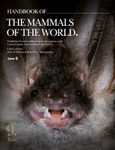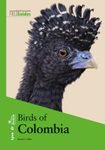Field / Identification Guide
By: Uthai Treesucon(Author), Wich'yanan Limparungpattanakij(Author)
452 pages, ~2200 colour illustrations, 1025+ colour distribution maps
![Birds of Thailand Birds of Thailand]()
Click to have a closer look
About this book
Customer reviews
Biography
Related titles
About this book
Thailand is justifiably the most popular country for birdwatching in South-East Asia. From dramatic hornbills and colourful but skulking pheasants and pittas to one of the rarest birds in the world, Spoon-billed Sandpiper, the country boasts year-round interest. This new field guide will help you identify all 1049 species to have been recorded in the country to date, including the 20 species endemic or near-endemic to Thailand.
- Taxonomy follows the Handbook of the Birds of the World and BirdLife International Illustrated Checklist of the Birds of the World.
- Detailed texts covering status, habitat and behaviour, age, sex and geographical variation, voice, and confusion species.
- Almost 2200 illustrations covering all species and distinctive subspecies, birds in flight, males and females, juveniles and non-breeding plumages, where appropriate.
- QR code for each species, linking to the Internet Bird Collection gallery of photos, videos and sounds.
- More than 1025 full-colour range maps for all species other than vagrants.
- Well-marked subspecies groups receive full accounts, and the distributions of subspecies breeding in the region are clearly mapped.
- Local species name and local conservation status included.
Customer Reviews (1)
-
Comprehensive, taxonomically up-to-date, QR codes
By
Gehan de Silva Wijeyeratne
30 May 2020
Written for Flexibound
Spanning a wide latitudinal range (from 6 degrees North near the equator to over 19 degrees North) and a multiplicity of habitats, Thailand is an astonishingly biodiverse country. Its unusual shape understates its geographical area of just over half a million square kilometres. That is around twice that of Britain and four times that of England. Given the combination of large landmass, latitudinal range from near the equator to the Tropic of Cancer, structural complexity from beaches to high mountains, it is not surprising that it is so species-rich. The book I have on the butterflies of Thailand is a door stopper covering just under 1,300 species. I have a field guide to reptiles published in 2015 which covers just over 350 species and I suspect there are many more cryptic species which have been overlooked. Birds are probably the best known faunal group and this new guide covers all 1,049 species recorded at the time of publication. A massive species list, amazing wilderness areas from coastal wetlands to cloud forests, well-developed tourism infrastructure and its delicious cuisine makes the claim highly plausible that Thailand is the most popular birding destination in South-East Asia
Having visited Thailand more than once, my field guide collection includes classics such as Ben King’s A Field Guide to the Birds of South-East Asia published in the 1970s, the later and very useful A Field Guide to the Birds of Southeast Asia by Craig Robson, a landmark publication in 2000 and A Guide to the Birds of Thailand by Boonsong Lekagul and Philip Round. None of these books has outlived their usefulness, but the new guide from Lynx Edicions does have a number of advantages. Its taxonomy draws on the Handbook of the Birds of the World (HBW) and the follow up to it, the Illustrated Checklist of the Birds of the World, both by Lynx Edicions. Therefore, the taxonomy is up to date and there are useful reminders in the species accounts on recent splits. The book also benefits from a suite of plates painted by some of the best bird artists in the world for the HBW.
The bulk of the book (pages 24-423) is the species accounts, with facing text. The plates typically have between four-six species only. Therefore, it makes for a lengthier book but the plus side is that the plates are not crammed with small illustrations and the text is of a generous length, although written in the telegraphic style of field guide text. The White Wagtail has an entire double-page spread to itself illustrating five subspecies which have been recorded as migrants. The text by two local lead authors Uthai Treesucon and Wich’yanan Limparungpatthanakij and four supporting authors, covers measurements, identification, distribution, plumages of different growth stages, geographical variation, similar species etc. Voice, critical for detection and identification of many forest species, is covered in good detail. Subspecies are generally are well covered although with some birds (for example Northern Sooty-headed Bulbul Pycnonotus aurigaster) references are made only to the key subspecies.
A new feature developed by Lynx Edicions is the addition of QR codes. This is a game-changer and I suspect more and more ornithological field guides will follow this lead. For anyone who has eschewed tech, it only takes a minute to download a free QR reader onto a smartphone. Holding it over the QR code brings up a link which you can click on to take you to an internet resource. Why it is so useful and not gimmicky is that the links provided make it easy to listen to calls and songs without the bother of having to search the internet for something suitable. The work has already been done for you. Another innovation is the flexible, synthetic cover which may offer some protection from the onset of rain which has ruined many a book in the field.
The species accounts are split by family demarcations, but the families don’t receive a brief introduction which is a departure from sister titles in the series. However, the number of extant species and what is found in the region are listed for each family. For example, the Leaf Warblers which are now in their own family the Phylloscopidae, are described as having 78 species in the world, with 30 in the region plus 3 vagrants. The colour-coded distribution maps don’t have their own colour or shading for vagrants but this may be discerned by blue dots (as opposed to a swathe of blue shading for regular migrants) to mark occurrences.
The front sections have a ‘General Introduction’ and ‘Geographical Scope’ which should be read in the trip planning stages as it has valuable pointers on what type of physical terrain and plant and avifaunal communities are found in different regions of the country. This is also complemented by a section on ‘Habitats’ which briefly introduces different habitats such as deciduous forest, bamboo forest and limestone forest. There are just over four pages on ‘Birding hotspots’ accompanied by a numbered map to 34 sites. A larger version of this map is also on the inside back cover and the latter would have benefited from a few of the larger towns and cities being marked on it for orientation. A surprising amount of information is condensed into the hotspot summaries from the type of habitat and key species to the all-important details of logistics; how to get there and where to stay. Although Bangkok is frequently ensnared in traffic I have found that one can move around reasonably well on Thailand’s motorways and this section does some good ideas on where you may be able to go birding even if your visit to Thailand is for a family holiday to a tourist hotspot rather than a bespoke birding tour.
The section on ‘Bird Conservation’ has a long and sobering list of species which warrants a threat category, due to various factors including loss of habitat, hunting and trapping. In the species accounts, the Thai names for birds are shown in Thai script no doubt inspired by the local conservation work undertaken by both of the lead authors. This field guide brings into the market, a sophisticated and thoroughly modern field guide which hopefully will become a platform to inspire more Thai nationals to take up birding. This will help to change attitudes against prevailing practices such as the trapping of wild songbirds and encourage a shift to enjoy watching birds in the wild.
29 of 34 found this helpful
-
Was this helpful to you? Yes No
Biography
After graduating with a Master’s Degree in Biology (Environmental Biology), Uthai Treesucon worked as a wildlife researcher at Mahidol University (Bangkok, Thailand). He led his first birding tour in 1983. He is an expert on identifying birds by their calls. Birding has taken him to more than 40 countries. Apart from Thailand, he has led birding tours to Vietnam, Myanmar and Borneo. Uthai is a former chairman of the Bird Conservation Society of Thailand (BCST) and still does voluntary work for the Society and is a member of the BCST Records Committee. He lives in Bangkok.
Wich’yanan Limparungpatthanakij graduated with a Master’s Degree in Biology from Mahidol University (Bangkok, Thailand), focusing on the ecology of avian mixed-species foraging flocks. He is a member of the BCST Records Committee and an eBird reviewer for Thailand. He has been involved in a number of ornithological and ecological research projects in Thailand, as well as being a freelance guide specializing in bird tours throughout the country, and an active volunteer for conservation NGOs.
Field / Identification Guide
By: Uthai Treesucon(Author), Wich'yanan Limparungpattanakij(Author)
452 pages, ~2200 colour illustrations, 1025+ colour distribution maps
"[...] For anyone planning a visit to Thailand this book is a must-have."
– Paul Stancliffe, BTO book reviews
"Overall, Birds of Thailand is a very impressive and very welcome field guide, and the two Thai authors and those who helped “prepare” the text (Alex Berryman, Christopher Sharpe, Guy Kirwan, and Tim Marlow) should be congratulated on producing an excellent book. Whilst the text is not as detailed as that in Robson’s guides, it does have the significant advantage of excellent maps, and if you are only going to Thailand you will not be confused by all the non-Thai species that are crowded onto the plates in Robson’s Southeast Asia guide."
– Frank Lambert (28-09-2019), read the full review at The Birder's Library























![Ageing & Sexing of Migratory East Asian Passerines [English / Chinese]](http://mediacdn.nhbs.com/jackets/jackets_resizer_medium/25/250760.jpg?height=150&width=115)
















